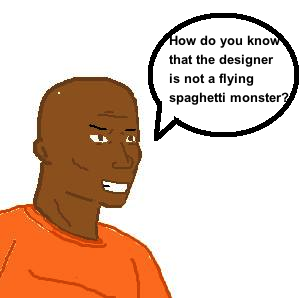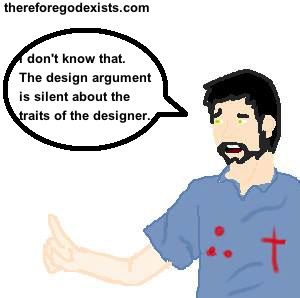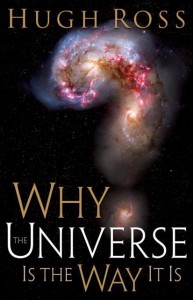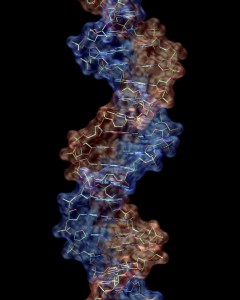 Is The Universe A Design? In history when men have presented designer hypothesis, admittedly, they were often guilty of being what is known as God Of The Gaps, which is to say that we do not know how a certain phenomenon came to be, and therefore it must have been God. As far as I can tell, this is the case in William Paley’s watch argument, and I often cringe when I hear my fellow Christians reciting the words, “Picture a watch…”
Is The Universe A Design? In history when men have presented designer hypothesis, admittedly, they were often guilty of being what is known as God Of The Gaps, which is to say that we do not know how a certain phenomenon came to be, and therefore it must have been God. As far as I can tell, this is the case in William Paley’s watch argument, and I often cringe when I hear my fellow Christians reciting the words, “Picture a watch…”
Now I love evangelism and arguments from design and so forth, however, when posed with a question of the validity of the scriptures, and we appeal to the complexity of human beings, I think my brethren are often setting themselves up to be steam rolled. Even if we grant that human beings are so complex that they require a designer, God so revealed by the scriptures would not be a justified consequences of the argument.
 In the same way, if the universe is proven to be a design, we cannot tell anything about the designer, aside from the fact that it is a designer. It may be the case that the designer of the universe is a Flying Spaghetti Monster, but the traits of such a creature would be unjustified given the data provided by design evidence. It may also be the case that this designer had a transcendent cause beyond itself. The question under consideration is not in regard to the attributes or traits of the designer. The question under consideration is whether there is a designer at all.
In the same way, if the universe is proven to be a design, we cannot tell anything about the designer, aside from the fact that it is a designer. It may be the case that the designer of the universe is a Flying Spaghetti Monster, but the traits of such a creature would be unjustified given the data provided by design evidence. It may also be the case that this designer had a transcendent cause beyond itself. The question under consideration is not in regard to the attributes or traits of the designer. The question under consideration is whether there is a designer at all.
The traits of that designer, whether it had a cause beyond itself, whether it revealed itself in mankind, whether it is benevolent, are simply not relevant to whether the universe is a design. Such things can be left in open question for future inquiry, but in this dialogue, they are completely irrelevant.
Having said that, I think my debate partner, who I will address as Martin, will be relieved that I am beginning this discussion with a note of common ground, namely, I do not think that complexity logically entails design.
Complexity Does Not Entail Design
 A good example, I think, may be what is known as the “man in the moon,” which is basically a series of craters in the moon that appear to be a human face when you can see the entire full moon. There is obviously a certain degree of complexity, but I would not argue that therefore, the designer of the cosmos imprinted his face in the moon. Instead, I acknowledge that it is just a coincidence. Complexity does not entail design.
A good example, I think, may be what is known as the “man in the moon,” which is basically a series of craters in the moon that appear to be a human face when you can see the entire full moon. There is obviously a certain degree of complexity, but I would not argue that therefore, the designer of the cosmos imprinted his face in the moon. Instead, I acknowledge that it is just a coincidence. Complexity does not entail design.
In contrast, suppose there were a series of missiles colliding into the moon and they spelled out the words, “Hello, earthlings.” I think we would obviously all say that this was a design by a designer, presumably, alien life. It is not the level of complexity here that suggests design, though. There may be things more complex that we would not recognize as design. Rather, what suggests that it is design is the corresponding pattern.
In fact when NASA explores the universe for intelligent life, they look for very basic patterns, like a series of prime numbers. Patterns suggest intelligence.
The Cosmos
 In the case of the cosmos, there is an extraordinary set of patterns, falling into a vastly small probability, which correspond with the existence of sentient life. They are what are known as Anthropic Constants. To explain Anthropic Constants I think I can take you back to the boyhood awe that I had. In third grade, I learned that the sun is placed just so, and if it were any different, life on earth would not exist. That is an Anthropic Constant.
In the case of the cosmos, there is an extraordinary set of patterns, falling into a vastly small probability, which correspond with the existence of sentient life. They are what are known as Anthropic Constants. To explain Anthropic Constants I think I can take you back to the boyhood awe that I had. In third grade, I learned that the sun is placed just so, and if it were any different, life on earth would not exist. That is an Anthropic Constant.
This example by itself, could, of course, be dismissed as a coincidence. However there are 122 Anthropic Constants, and they apply not only to life on earth, but also to sentient life across the entire known universe. I will appeal to yet another example.
Suppose we had a ruler that stretched across the entire known universe, marked in inches. Gravity is on a particular inch mark (I know that gravity is not measured in inches or distance, this is a mathematically equivalent illustration). If gravity were moved to any other inch mark, there would be no sentient life in the universe. So the same with the expansion rate of the universe, the balance of matter and anti-matter, and so on.
Challenged by the discovery of the Anthropic Constants, the atheist astronomer Fred Hoyle remarked, A common sense interpretation of the facts suggest that a super intellect has monkeyed with physics, as well as chemistry and biology, and that there are no blind forces in nature.
The enormous pattern that corresponds with the very ability for any sentient life to exist has convinced multiple scientists such as Robert Jastrow, a former agnostic, as he explained in his book God And The Astronomers, and the former atheist Anthony Flew, as he explained in his book There Is A God. A design hypothesis is not something that is regarded as laughable by honest seekers given the available data. They are instead often regarded as very challenging given in the design in the cosmos.
Simplicity To Complexity?
 Often a naturalistic account of how life came to be would entail an explanation of a grueling process of natural selection, including mutations, adaptation, and so forth, and this is how we can explain the complexity of human beings. Rather than looking to a human being and saying that we must have had a designer, we can look to a human being and say that we came from a lower primate, and eventually, if you follow our ancestral heritage, we will find a one-celled amoeba. Simplicity to complexity.
Often a naturalistic account of how life came to be would entail an explanation of a grueling process of natural selection, including mutations, adaptation, and so forth, and this is how we can explain the complexity of human beings. Rather than looking to a human being and saying that we must have had a designer, we can look to a human being and say that we came from a lower primate, and eventually, if you follow our ancestral heritage, we will find a one-celled amoeba. Simplicity to complexity.
This may have made sense in the day of Charles Darwin, because a one-celled amoeba does not appear to be all that complex. But with the discovery of the DNA molecule, we find that a one-celled amoeba is extraordinarily complex, and not complex in the way that the man in the moon is complex. This is what we can regard as specified complexity (which is basically what I explained in the previous section, namely, complexity that has a corresponding pattern).
Note well that this is not an argument against macro-evolution. This is an argument for the specified complexity of DNA, which is consistent with macro-evolution. To explain what I mean, consider the illustration that I used above, that if a series of missiles spelled out a message, we would immediately assume that there was a mind behind that message. We would not think that space junk collided into the moon to coincidentally spell out “Hello, earthlings!”
Similarly, if you found a box of overturned alphabet cereal with a bunch of pieces spilled onto the table, and they spelled out the sentence, “Take out the garbage. – Your loving wife,” I do not think we would be compelled to say that the box randomly spelled out that phrase after being knocked over. Instead we would immediately recognize that this message came from an intelligent mind.
In the same way, the messages provided by the DNA molecule prove that there must be a mind behind it. DNA is like a language, the only difference is that it has 4 letters instead of 26, and as Richard Dawkins pointed out in his book The Blind Watchmaker, DNA has more information that 1000 encyclopedias combined. This is to say that if we were to take the four letters of the genetic alphabet and write out all of the information in DNA, we would have more information than 1000 encyclopedias.
In the words of Doctor Frank Turek, to suggest that this much information came to exist by natural forces is like suggesting that a library was the result of an explosion at a printing shop. There is no natural law that can produce specified complexity, as simple as the message “Hello, earthlings!” much less a natural law that can produce 1000 encyclopedias.
Conclusion
The specified complexity in the cosmos that permits any sentient life, and the specified complexity in all living organisms on earth suggest to me that the universe is a product of design. But I say again: the traits of this designer are not known by looking at this specified complexity. It may be the case that the designer had a transcendent cause, and it may be the case that the designer is a Flying Spaghetti Monster.
We can ask, “who is the designer?” as a further question, but we cannot ask who the designer is as an attempt to refute the notion that the universe is a design.
First of all I’d like to thank Richard for this opportunity to debate him.
As I understand it, Richard is relying on two arguments in this debate. Firstly, the Universal constants conducive to the existence of sentient life. Secondly, the nature of DNA in living organisms as we know them on Earth.
Universal Constants
It can be agreed that the Universe has such properties as allow the existence of sentient life. That is evident by the very fact that we, sentient creatures, are here.
However, is this in any way, shape or form, evidence of a
designer? I think not.
First of all, I’m not familiar with any evidence that would suggest that these constants are in any way “tuned-in” to the existence of sentient life, as opposed to life per se. In other words, Richard appears to be suggesting that, if some of these constants were different, life would still possibly exist, but wouldn’t be sentient. I don’t see any basis for such a claim. I would, however, agree that the constants are such that allow the existence of LIFE. Does that mean that the Universe was set up in this way in order for life to exist? Or is the simple (and obvious) reverse true, namely that LIFE EXISTS BECAUSE THE UNIVERSE IS SUCH AS TO ALLOW IT? Had the Universe been different, it would be lifeless. It’s not different and therefore life exists in it.
To take matters further, life has only existed for a fraction of the Universe’s lifespan and advanced sentient life (namely humans) have been around but for a few seconds in universal terms. What’s more, the vast majority of the Universe is very, very unfriendly to life. According to Smolin, had the Universe been a house, life-friendly parts of it would be smaller than a proton. Imagine a house that has stood for a year with many things happening inside it and for a couple of seconds in that year, a particle smaller than a proton appears. Would it make any sense to claim that this house was built for the purpose of this particle? Of course not. And yet, that’s exactly what we’re talking about when it comes to saying that the Universe was designed for sentient life.
In fact, again according to Smolin, if the Universe has been designed for anything at all, it is for the existence of black holes. Black holes wouldn’t be possible in any different Universe. In addition, black holes comprise billions (if not trillions) of times more mass than do life-friendly bits of the Universe. And, of course, black holes have existed a long time before sentient life arose and are likely to exist for a very, very, very long time after we are gone.
An intelligent entity capable of creating universes (with all their laws and complex properties) would be very much able to create a universe whose laws allowed sentient creatures to roam freely all over the place. Had such a universe existed, the claim that it was designed for sentient creatures might well have some merit. But this humongous, empty, cold (except for small spots where it is extremely hot – millions of degrees) and depressurised bubble of nothing? Hardly.
I agree that it does seem natural to think about the Universe as being purposed for us. But that’s because of our nature. Looking for purpose and design is second nature to us. We are naturally tuned to look for intelligence. There are, of course, very good biological (evolutionary) reasons for it. There is also much data that shows that people tend to look for patterns, intelligence and purpose in places where there are none (eg, completely random images used in some experiments, but of course there are many examples more).
Given our natural (and proven so misleading) tendency to find purpose combined with the fact that we are an extremely tiny fraction (effectively nothing) in the size and timeframe of the Universe, it seems unlikely that it was in any way designed specifically for us. Much more unlikely than that it was designed specifically for black holes.
Now just let me return to those constants. Scientists are in heated debate about how many constants there really are as well as about how independent they are of each other. It’s actually not impossible that they all come down to a single property of the Universe. They have no idea how many universes there are, how many there have been, how universal constants are generated, what laws (if any) apply to this process. To draw any probabilistic conclusions in such a non-existent state of knowledge is comparable to charging a person with murder based on the fact that they live in the same town as the deceased victim. These are interesting questions to explore. They are fascinating. But none of this entails any conclusion that the Universe was designed, let alone designed for sentient life.
Is the idea preposterous? No, it’s not. It’s simply not supported by the evidence that we see. Does that mean that we should abandon the hypothesis that there was a designer? No, not at all. Those who enjoy this hypothesis are free to put together models and look for evidence to confirm those models. They can look for actual evidence of an entity that’s capable of creating universes. No Zeus, no Yahweh, not even the poor old Flying Spaghetti monster. No deistic nameless god either. No evidence. None at all. Once they find such evidence, their hypothesis will carry some credit.
DNA
Let me now move to the second part of Richard’s argument; the DNA.
Here Richard seems to commit the same old fallacy, so often committed by ID proponents; Strawman. A Strawman is committed when a debater attacks an argument that his opponent has never made. You build a man of straw and instead of punching the enemy, you punch the doll. I’m not suggesting Richard is doing this deliberately. I respect him as an honest and conscionable debater; let’s make that very, very clear.
Nobody in the world of science is suggesting that DNA, with its complexities, just happened to exist accidentally. There are no library explosions. That claim is made of straw. Instead, it is believed by the vast majority of mainstream science that DNA evolved from a much simpler molecule, often referred to as a “replicator”. Scientists know of molecules that can act in such a way and the DNAàRNA replication is but one example of that. The properties involved are often compared to enzymes. Essentially, we are talking about molecules “shaped” in such a way that, when they are in contact with a rich mix of chemicals, they will generate a copy (or a negative copy) of themselves. All that is required is adequate exposure. This replicator molecule would have to have generated randomly. And, on the face of it, that’s very, very improbable. Until you take into account the sheer size of the vast universe, of course. A universe in which billions of simultaneous “attempts” could be taking place. We can compare this to winning a lottery. If you play once, you are indeed very unlikely to win (though someone usually does!) But if you play ten billion times, you will almost certainly get it right, probably more than once. Scientists are currently on a hunt for how this process (called abiogenesis) could occur. And they come up with some results. Of course, it may be a very long time (if ever) before we find out exactly how it happened.
It is then believed that this replicator evolved via the (now familiar to us) process of mutation and natural selection – evolution. Once you have replication and (necessary with it!) heredity COMBINED with occasional copying mistakes (mutation), you’re in business. Natural selection does the rest. Richard isn’t taking issue with macroevolution and therefore the facts of mutation and natural selection are not going to be contested. So, no library explosions, just a page-by page collection over eons and eons of time, with pages falling through randomly and only those getting attached that happen to fit the clip.
Is abiogenesis more probable than design? The vast majority of scientists (people who spend whole lives on this and get paid very little) seem to think so. Do I think so? I don’t need to. The burden of proof is on Richard. He must show that design is MORE PROBABLE than abiogenesis. And that’s just to make a prima facie, weak case for “a designer probably once has existed”, far from “there is a creator god”.
Conclusion
I conclude by saying that there’s no ground for a claim that the Universe was designed to sustain life or that DNA was more likely the product of design than of purely natural causes.
Ps: Richard, I have the Blind Watchmaker and the only reference Dawkins makes to books in a library is in the context of his explanation of taxonomy. Are you perhaps thinking of another book?
First rebuttal can be found here: https://thereforegodexists.com/2013/04/is-the-universe-a-design-first-rebuttal/